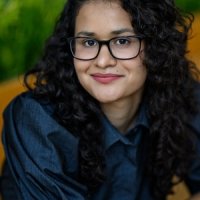If the suffering of Afghan women is real and harrowing, then the global response often feels surreal, like a performance disconnected from the reality it claims to address.
To approach the Other “is to receive from the Other beyond the capacity of the I,” as Emmanuel Levinas wrote. The Other is not just a stranger that we encounter but is also a part of ourselves that defies full understanding. For me, the Other is both the self that I left behind at 20 and the version of myself imposed by Western narratives—the Afghan woman cloaked in a burqa, seen but never heard.
The burqa, while a potent symbol, has been overused to flatten the identities of Afghan women into a singular narrative of victimhood. But what lies beyond the burqa? To truly understand the Other, we must look past the veil of simplicity and engage with the layers of contradiction, agency, and resilience that define Afghan women’s lives, and, by extension, the infinite complexity of all Others.
Who is the Other?
When I moved to the United States, I encountered a new Other. It was not someone outside me, but a version of myself that existed only in the imaginations of others. My 20-year-old self, who had lived freely and without explanation, was replaced by the “Afghan woman” envisioned by Western audiences: oppressed, silent, and cloaked in a burqa.
This narrative was not mine, yet it followed me everywhere. My identity had been overwritten by a global script that reduced Afghan women to symbols of suffering and was used to justify interventions that seldom asked for our voices.
The burqa became the centerpiece of global narratives about Afghan women, used to project a singular image of oppression. TIME Magazine’s 2010 cover featuring Aisha, an Afghan woman mutilated by the Taliban, encapsulated this approach. While it drew attention to the horrors Afghan women faced, it reduced them to symbols of victimhood and sidelined their agency and roles in shaping Afghanistan’s and their own future.
In 2001, the Oprah Winfrey Show featured a theatrical performance involving the burqa. In the aftermath of 9/11, Oprah and her team featured models parading in burqas to dramatize the suffering of Afghan women. The show invoked gasps of horror from the audience, as though the garment itself encapsulated the entirety of Afghan women’s suffering. The performance was devoid of nuance, context, or any meaningful engagement with the lives of Afghan women. Instead, it was a spectacle that centered the Western audience's feelings of pity and righteousness instead of the voices of the women it claimed to advocate for.
As if the absurdities of life under the Taliban weren’t enough, Afghan women must also endure the well-meaning but tone-deaf interventions of Western celebrities. Meryl Streep’s recent comments at the UN General Assembly offered a stark illustration. In a speech meant to highlight the plight of Afghan women, she declared: “a female cat in Kabul has more freedom than a woman. A bird can sing, but a girl cannot.” At first glance, these words might seem poetic, even compassionate, but they ultimately serve to obscure rather than illuminate. Instead of engaging with the lived realities of Afghan women, Streep’s metaphor reduces them to voiceless creatures, trapped in a narrative that exists more to elicit pity than to reflect their full humanity.
These spectacles of advocacy have turned Afghan women into objects of pity rather than subjects of their own stories, erasing their voices in the process. However, Levinas reminds us that the Other is infinite. It exceeds any attempt to define them.
Engaging with the Other
Afghanistan is a land of contradictions. The very allies that were ‘promoting women's rights’ celebrated the warlords responsible for atrocities as champions of democracy. To understand the Other in Afghanistan is to confront these contradictions, not dismiss them as ‘cultural.’ The Other is not a fixed identity but a dynamic, evolving presence shaped by layers of history, politics, and personal experience. To approach the Other ethically, we must resist simplifying these contradictions and instead embrace the complexity they represent.
If the suffering of Afghan women is real and harrowing, then the global response often feels surreal, like a performance disconnected from the reality it claims to address. Advocacy, in many cases, has become a spectacle of symbolic gestures.
To truly engage with the Other, we must go beyond the burqa, the symbols, and our own need to feel like saviors. Afghan women are not waiting for poetic metaphors or viral campaigns. They are risking their lives every day to resist oppression. Ethical engagement requires humility, action, and, above all, a recognition of their agency.
“To have the idea of infinity,” Levinas writes, is to recognize that the Other exceeds our understanding at every moment. For Afghan women, this infinity lies beyond the burqa, beyond the symbols used to define them. It is found in their contradictions and their agency.
The views represented in this piece are those of the author and do not express the official position of the Wilson Center.








